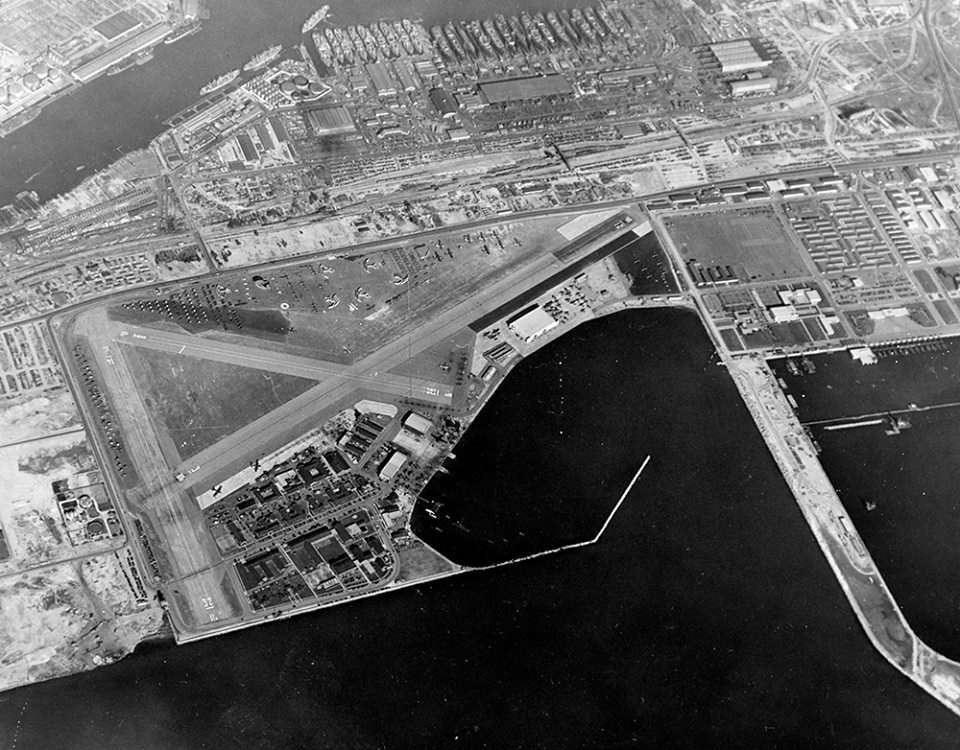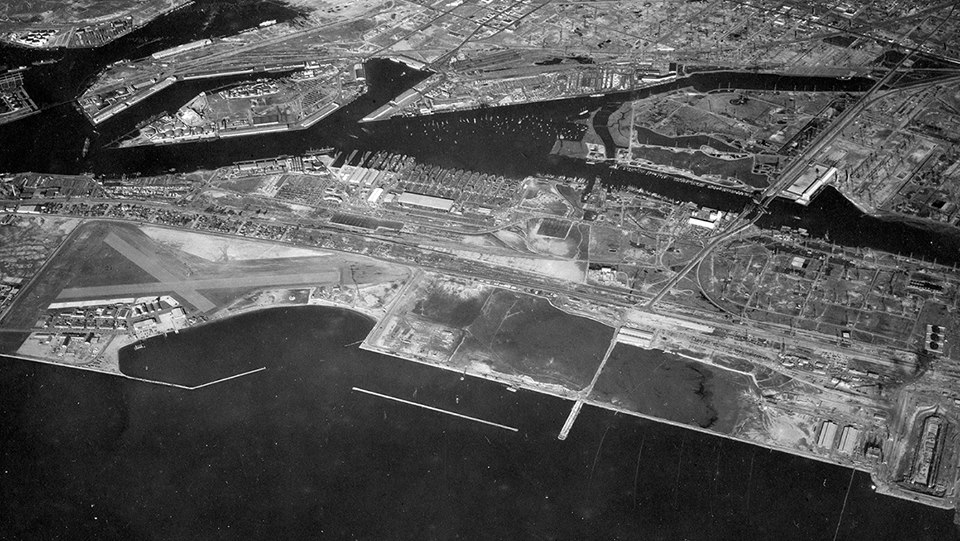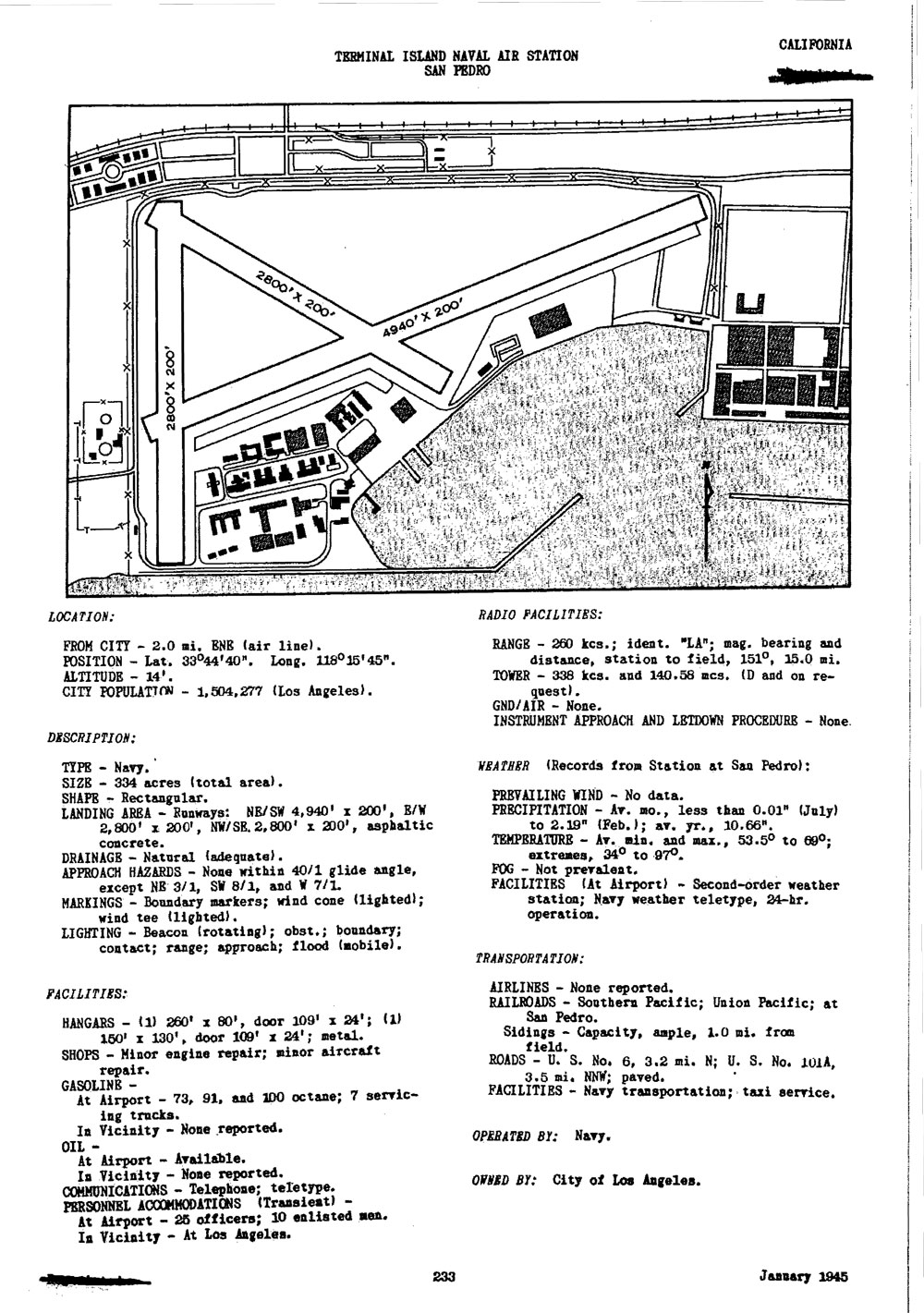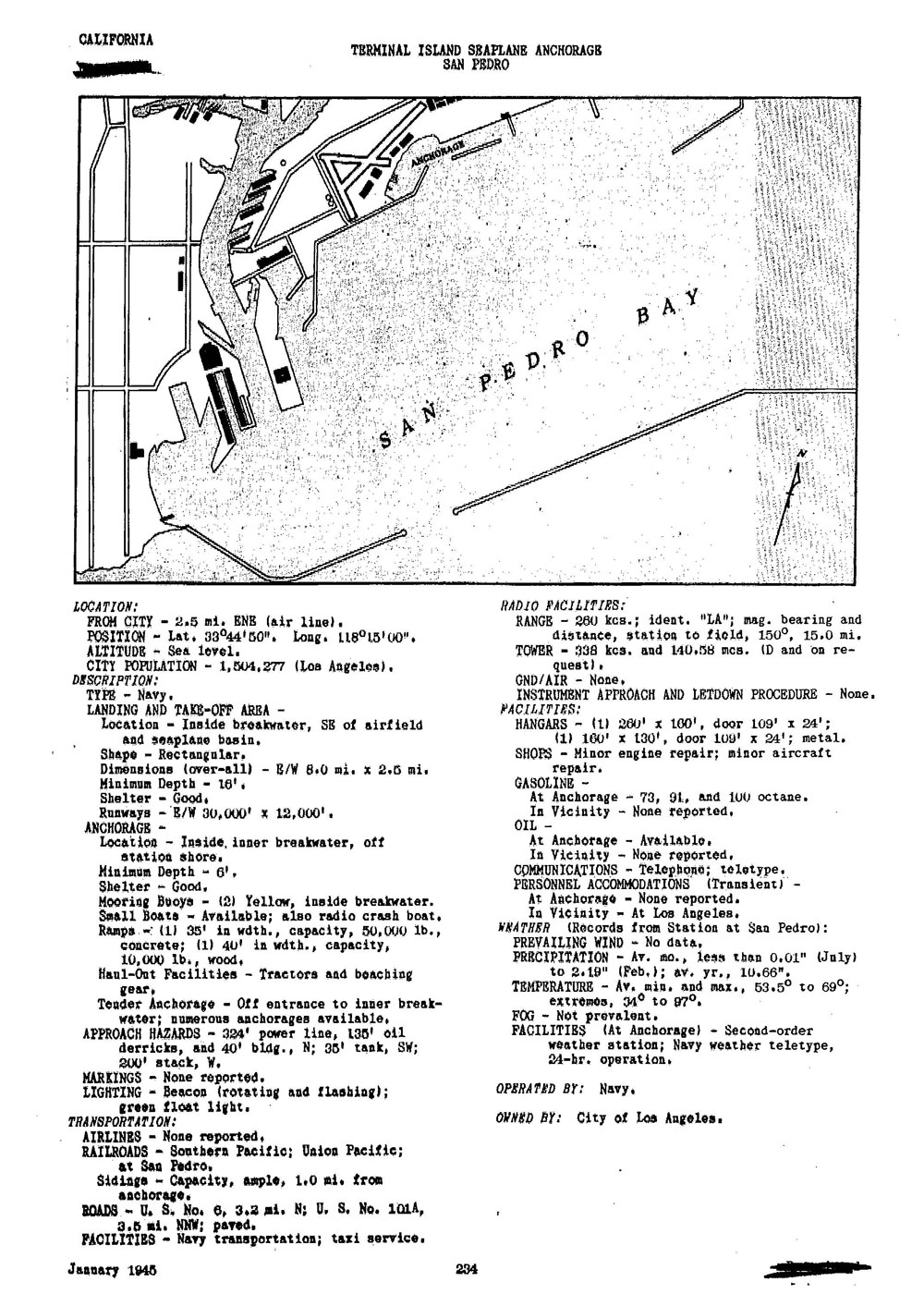

Allen Field was a small 410-acre civilian airport built in 1927 on a portion of the expanded section of Terminal Island. Terminal Island is a sand-filled island located adjacent to the port of Los Angeles and expanding between the harbors of San Pedro and Long Beach.
Located approximately equally between three cities, San Pedro, Wilmington, and Long Beach, it was reached by each city by taking a foot ferry or one of the Red Cars operated that were operated by the Pacific Electric Railroad. The field itself consisted of three paved runways (the largest being 4,200 feet long), a large seaplane ramp, and several hangars and other buildings.
The U.S. Navy began its use of Allen Field almost from the very beginning. In 1927 a Naval Air Reserve Training Facility was established there. With the U.S. Naval Reserve Training Camp located across the harbor at the Submarine Base in San Pedro, it was an ideal location. With its large seaplane ramp, the airfield at Terminal Island soon became the primary operating base for seaplanes assigned to ships of the Pacific Fleet.
In 1935 the Navy took complete control over Allen Field and in 1936 designated it as a Naval Air Base (NAB San Pedro) and renamed it Reeves Field, in honor of Rear Admiral Joseph M. Reeves, Naval Aviation Observer and farseeing pioneer in the tactical employment of aircraft carriers.
Terminal Island was one of the first islands seized from Japanese fishermen and cannery workers shortly after Pearl Harbor was attacked.
Early in1942, the Naval Reserve Air Training Facility at Reeves Field was turned over, along with its facilities there, to other Naval units of the Pacific Fleet and relocated to NAS Los Alamitos, and NAB San Pedro was redesignated as a Naval Air Station (NAS) Terminal Island. Even though Reeves Field was operational as a Naval Reserve Air Training Facility from 1927 to 1942, it continued to play an important training role to Naval Reserve Air personal through 1945.
In 1942, NAB San Pedro, now NAS Terminal Island, was now relegated to the task of equipping and perform flight-tests on a large number of military aircraft produced at the nearby plants of Lockheed, Douglas & Vultee. To facilitate delivery of these aircraft, the U.S. Navy established the Naval Air Ferry Command (NAFC) in 1943. This was a wing of the Naval Air Transport Service (NATS), and three Air Ferry Squadrons were commissioned, VRF-1 at NAS New York, VRF-2 at NAF Columbus, Ohio, and VRF-3 at NAS Terminal Island, California. Originally called Air Delivery Units (ADUs), the ADUs and ferry squadrons used small transports to ferry pilots to the manufacturer's plant to pick up the aircraft and then the transport would fly to the station where the aircraft were delivered to bring the pilots back to either the factory for another flight or to their home station.
The commander of NAS Terminal Island was Captain Kneflar "Socko" McGinnis, who had been awarded the Navy Cross for transporting the first mass flight of seaplanes from Northern California to Hawaii.
Also stationed at NAS Terminal Island were a small group of women, whose contribution to the war effort has often been overlooked. These women were part of an elite group of the Navy's WAVES (Women Accepted in Volunteer Emergency Services). (1) Of the 25,000 WAVES and 1,900 SPARs who became part of naval aviation in jobs as mechanics, air traffic controllers, and radio and air navigators in World War II, about 200 of them worked at Terminal Island. These women played an important role in the Naval Air Transport Service. Day and night, hundreds of new planes roared in and out of Reeves Field, one of the busiest naval ferrying air stations on the West Coast. Planes just off assembly lines were flight-tested here and then "pickled" with a protective coating to protect them against salt air before they were shipped to the South Pacific.
Reeves Field also served as a training field for men having just completed Naval Air Navigation School. Interestingly enough, a few of the WAVES assigned to NAS Terminal Island were qualified as Navy aerial navigators (2) and trained hundreds of men naval aviators and navigators from the Naval Reserves at Reeves Field.(3)
Even so, with the Naval Reserve Training Facility having been transferred in 1942, NAB San Pedro's status was downgraded to that of a Naval Air Station (NAS Terminal Island) in 1943. Both NAS Terminal Island and NAS Los Alamitos remained under the command of the Naval Operating Base at San Pedro, California, until August 10, 1944, when they both fell under the jurisdiction of the Eleventh Naval District. The Long Beach Naval Station (NAVSTA Long Beach), which was not established until 1941, became located adjacent to the airfield. Reeves Field as a Naval Air Station was disestablished in 1947, although the adjacent NAVSTA Long Beach would continued to utilize Reeves Field as an auxiliary airfield until the late 1990s, at which time the land was made available to Los Angeles for critically needed port expansion to the south. The name of Reeves Field was later transferred to the Naval Air Station in Lemoore, California, where a new airfield was established in 1961 for the U.S. Navy's fighter and attack bombers.
Footnotes
(1) To free up men for sea service, thousands of women jointed the Navy in the newly organized women's unit called WAVES, and a few thousand more enlisted in the Coast Guard's women units called SPAR (short for Semper Paratus, "Always Ready").
(2) On March 30, 1945, as the war neared its end, the Navy authorized a distinctive gold wings insignia for the 80 airborne female navigators, all of whom until then had worn a 1920s design "observer" wing with a compass in the center over crossed anchors.
(3) The pilot in training sat in a mock-up training cockpit wearing a headset, a WAVE would sit at a desk just outside, also wearing a headset, sending Morse code signals to the pilot, changing wind speeds and charting his path on a map to see how well he could follow the course changes. Hundreds of aviators and navigators were trained this way.

Long Beach and San Pedro serve as the harbor for the greater Los Angeles area. During World War I, the Navy established an operating base at San Pedro that remained in use through the 1920s and 30s. In 1935, a need arose for an aviation facility to support the floatplanes of battleships and cruisers. The harbor's sand-filled Terminal Island was leased for no charge from the City of Los Angeles. The WPA provided initial construction of the break water, a seaplane ramp, a concrete parking mat, and three runways that reached completion in June 1937. Work continued with the addition of hangars, barracks, and other facilities in the fall. The station commissioned on March 1, 1938, as NAS San Pedro, and went through a series of name changes before finally settling on Terminal Island.
In early 1939, the Navy began construction of a training facility nearby, named Roosevelt Base, and a shipyard. On October 1, 1941, the Navy formed an Aircraft Delivery Unit (ADU) at the air station. Shortly after the attack on Pearl Harbor, the Army stationed P-40 and P-38 interceptors at the airfield with the permission of the Navy. In January 1942, VS-46 began operating the inshore patrol mission from the base with 12 OS2U Kingfishers. The same month, the Army built eight concrete revetments on the airfield to protect its aircraft. The primary mission of the air station became the major West Coast Aircraft Delivery Unit. In the last six months of 1942, the ADU commissioned 200 aircraft a month from the Douglas and Lockheed factories in the area including the SBD, SNV, PV, and the A-24 (SBDs for the Army). Meanwhile NATS's VR-2, began three flights a week.
During 1943, activity continued to rise. VR-2's ser vice increased to daily with VR-3 beginning two daily transcontinental flights. Scouting squadrons continued operating from the station and from August to December of the year, VS-52 conducted operational training with SBDs. During the year, the ADU's deliveries averaged 434 aircraft a month including Culver TD2C drones, PB2Bs, PB2Y-3R transports, Canadian produced SB2Cs, and PBYs from Consolidated's new plant in New Orleans. Terminal Island reached the limit of its capacity; therefore, an Auxiliary Aircraft Acceptance Unit opened at Litchfield Park, Arizona, to accept the PB4Ys Liberators from San Diego. On December 1, the ferry squadron, VRF-3, commissioned at Terminal Island. Army continued to operate interceptors and added antiaircraft guns plus barrage balloons. During 1944, the station started performing aircraft modifications. At the end of 1944, the ADU began receiving the new Lockheed PV-2 Harpoon. VJ-12 also arrived and remained to war's end.
Terminal Island had three asphalt runways with the longest 4900 ft. In March 1944, personnel totaled 341 officers, 1274 enlisted men, and 420 civilians. Billeting was available for 171 officers and 1054 men. Peak utilization of the station occurred in the spring of 1945, with over 300 aircraft on board. VRF-3 operated 18 aircraft -- mostly light transports. The station proper had approximately 20 aircraft assigned. An Assembly and Repair Department maintained an aircraft pool that reached over 100.
Terminal Island closed in 1947, and its property assigned to the Bureau of Yards and Docks. Growth of the Long Beach Naval Shipyard eventually obliterated the former airfield's runways. The 1995 Base Realignment and Closure Commission recommended closing the shipyard.
Other Online Histories
Extract, US Navy and Marine Corps Installations - Domestic (1985)
Extracts, US Army Air Forces Directory of Airfields (January 1945)


UPDATED 5 May 2015